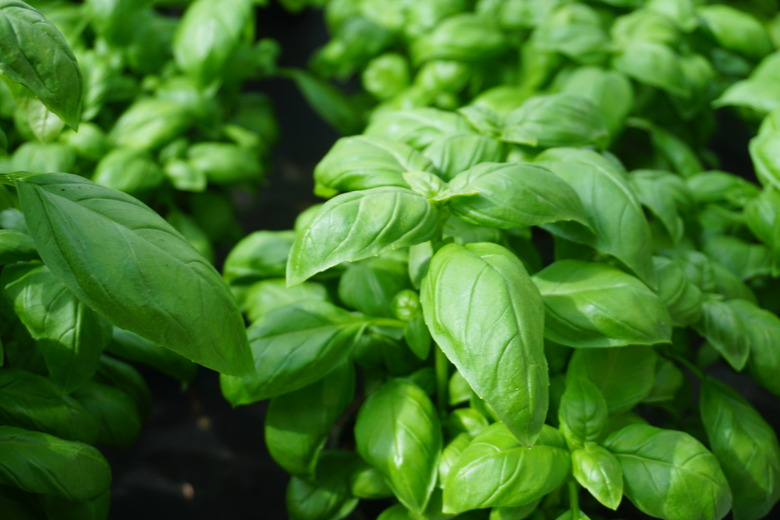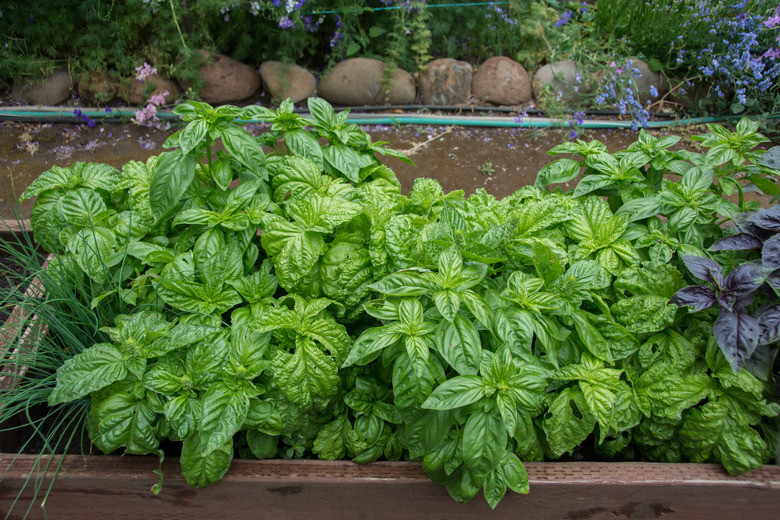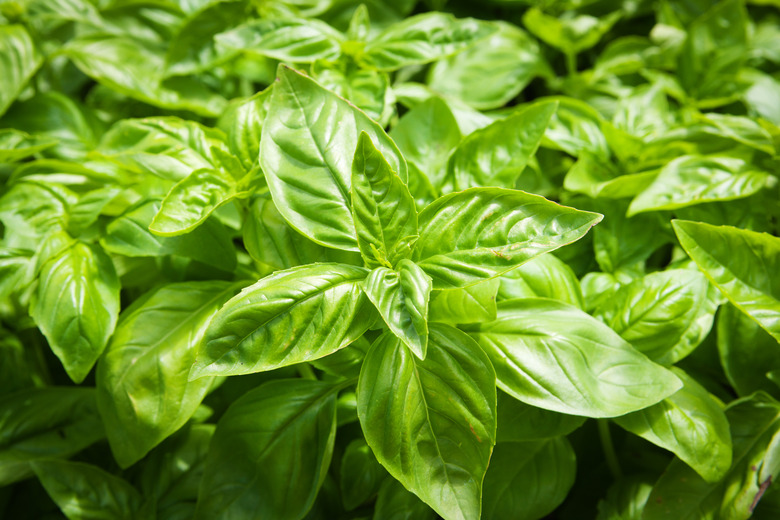How To Grow Basil
Sweet basil (Ocimum basilicum) is a fragrant herb that's beloved the world over. Known primarily for appearing in delicious Italian dishes and turning up as pesto topping penne pasta, fresh basil is one of the easiest and tastiest ways to add flavor to a meal.
Sweet basil plants are annual herbs that come from the mint family (Lamiaceae) and are known for their large, bright-green leaves that grow throughout the summer. These plants enjoy warm weather, as their cold hardiness begins to be impacted when the temperature drops to below 50 degrees Fahrenheit. Even though the basil growing season might be short, it makes up for it by being an extremely fast-growing plant. The bonus? It's very easy to grow.
There are over 160 basil varieties, and there are a few you may want to consider growing in your herb garden. Thai basil comes from Asia and is known for its spicy basil flavor reminiscent of licorice. Lemon basil, or Thai lemon basil, originated in Asia and Africa and has a piquant lemon aroma and taste. Genovese basil is one of the best-loved basil varieties for cooking. Purple basil has a deep-purple color with a clove-like flavor that's said to not be as sweet as its other basil relatives.
Although most basil species are annuals, holy basil (Ocimum tenuiflorum, formerly O. sanctum) is a frost-sensitive perennial in zones 10 and 11. Regardless of species, all basil plants prosper in the same growing conditions.
Best Uses for Basil
Add a sprinkle of basil to your pasta, muddle it down into an herby cocktail—however you use basil, it's guaranteed to add a freshness to any dish. You can even gather a handful and use the stems in flower arrangements to take advantage of the bright, beautiful leaves and herbaceous scent.
As for where you should be planting basil in your yard, this would be a spot that receives six to eight hours of sun. Basil plants adore full sun but can also do well in partial shade. You can plant them in raised beds, where basil plants tend to be especially successful. Otherwise, these plants can thrive in containers placed in direct sunlight.
As for growing basil indoors, it can be done. Simply use organic potting soil, distribute a packet of seeds among as many 4- to 6-inch pots as you need and put them on or near a bright, south-facing window. If you don't have a sunny window, consider a grow light for your plants.
How to Grow Basil
- Common Name: Basil
- Botanical Name: Ocimum spp.
- When to Plant: Two weeks after the last frost
- USDA Zones: Most species are grown as annuals in zones 2-11
- Sun Exposure: Full sun
- Soil Type: Well-drained, moist soil
- When it's in Trouble: Basil plants are in distress when the
leaves are anything but green. Yellow,
brown and black leaves are signs of overwatering or poorly drained soil. - When it's Thriving: The leaves should be vibrant,
glossy and fragrant.
Starting Basil From Seed
If you choose to sow seeds instead of purchasing basil seedlings from a greenhouse, you'll be pleased to know that it's an easy process, and basil seeds usually do quite well. Sow seeds about 1/4 inch deep and 10 to 12 inches apart. You'll spot those first seedlings in only seven to 10 days. If you're starting with seedlings, plant them in holes with ample soil and plant deep enough to cover the roots. Each seedling should be 10 to 12 inches apart.
You can start basil from seeds indoors too. You'll need to sow them about six to eight weeks before the last frost of the spring, placing them on a warm and sunny windowsill.
In What Zone Does Basil Grow Best?
Basil can grow as an annual in zones 2 to 11. Know, however, that if you live in a cold-weather region and you'd love to grow basil, you will need to take some precautions. If the temperatures are at risk of dipping into the 40s (below where basil likes it to be) even after the last frost, keep the plants under a tarp or straw overnight to safeguard them. You can also consider growing your plants in pots so you can choose to bring them into the protection of the indoors at a moment's notice.
When Should You Plant Basil?
You should pay attention to frost dates when planning to plant basil. Basil should be planted two weeks after the last frost when the soil is between 50 and 70 degrees. Just be sure to keep an eye on nighttime temperatures and make sure they're not dropping below 50 degrees. You'll be happy to know, however, that you can plant basil fairly late in the season. Since it's so fast growing, you could hypothetically plant basil in July and harvest it before the first frost hits.
Soil, Sunlight and Water Recommendations for Basil
When growing basil, aim for soil that's well-draining and moist. You can help the soil retain moisture better if you use mulch around the plants. If you're cooking with your basil, avoid using pesticides and plant it far from driveways and streets to avoid exhaust. This will make the soil as well as the foliage cleaner.
Ensure that wherever you plant your basil, the plants will receive around six to eight hours of direct sunlight, although they will tolerate partial sun as well.
As for watering, basil needs around 1 inch of water per week, which will keep the soil at an ideal moisture level. Moist soil will help the roots grow deep and will keep your plants healthy and happy. If you're growing your basil in a container, be sure to choose a pot with drainage holes and simply water your plant whenever the soil is dry to the touch until water runs out the bottom.
How to Harvest Basil
It's a very straightforward process to harvest basil. You can remove a few leaves at a time if you're intending to include fresh basil in a recipe. Otherwise, you can choose to gather entire stems full of leaves if you're aiming for a bigger harvest.
As soon as the plants are full grown, or 6 to 8 inches tall, you can go ahead and start harvesting basil. If you want to harvest leaves at their best (and juiciest), aim for first thing in the morning after the dew has dried from the leaves. Picking the leaves frequently will encourage new growth throughout the season, and generally, the leaves don't need to reach a certain size before they are ready to pick.
Experts say that for more flavorful basil, it's best to prune your plants about once a month. Pruning can also nurture even more growth. You can prune your basil plants right after planting them, cutting them down to just above the bottom two sets of leaves.
You should avoid allowing the purple flower buds to appear on your plants, as this means that your leaves may start tasting bitter. You can prevent your plants from flowering by pinching them, which means you'll manually pinch the central stem back by half with your fingers and right above the leaf axils, or where the shoots develop.
After you've harvested the basil, you have some options. You can cook with the fresh leaves, or you can dry them. Simply wash the leaves and when they're completely dry, lay the leaves on a single layer of paper towels and microwave them on low for three minutes. You can also use a food dehydrator for slow-drying the leaves.
You can turn to this DIY way to freeze the basil leaves so you can use them anytime. You'll chop clean basil leaves and drop the pieces into ice cube trays with olive oil to preserve them in your freezer. Once the cubes are frozen, place them in freezer bags. You'll be able to melt them and use them whenever a dish needs a kick of basil.
Common Pests and Other Problems for Basil
There are some pests that can be extremely bothersome to basil plants:
- Slugs and snails: Even though these garden creatures
can be cute, they can wreak havoc on basil plants. You'll know that your plants
have fallen victim to slugs and snails when you see irregularly shaped holes in
the leaves and stems. You can relocate slugs and snails as soon as you spot
them, or you can drop crushed eggshells around the plants. They have sharp edges that
the animals would prefer to avoid, and they will deter them from crawling on your
plants. - Japanese beetles: These copper-colored, iridescent
bugs enjoy basil. You'll know if they've stopped by if you view skeletonized leaves
on your basil plants. The beetles can be handpicked off the plants, or you can
head them off at the pass with row covers. - Spider mites: As tiny pests, spider mites make equally
tiny spots that can appear on basil leaves. If this is a problem for your
plants, the leaves will curl and turn yellow. You can prevent spider mites from
gravitating toward your plants by watering the plants well during dry spells
and preventing the ground from becoming dusty. - Aphids: You may be able to see these miniscule
bugs actively crawling on your plants. If they've begun to decimate your
plants, the leaves will turn yellow. Reflective mulches and silver plastic can
be effective to keep them at bay, and spraying these pests with water will dislodge them from your plants.
There are some other problems that can plague basil plants. If you're watering your basil plants more than the prescribed 1 inch per week, you're likely overwatering them, and you'll know when the leaves turn yellow and begin to droop. If you're underwatering, the leaves will begin to wilt, and the soil will feel dry to the touch.
As long as your soil is well-draining, basil should be able to survive in any type of soil, even if the quality is poor. It does prefer a soil pH of 5.5 to 7.5, and plants typically do better in a raised bed.
Common Diseases for Basil
There are some common diseases that can impact basil plants:
- Downy mildew: Yes, this condition is as unpleasant
as it sounds. Your basil plants can catch this disease from infected seeds or
from spores carried by the wind. For this, you'll need to use a fungicide made
specifically for downy mildew that's safe to use on basil plants. - Bacterial leaf spot: This disease, appearing as
black or brown spots, can be brought about by contaminated seeds or infected
soil. There's really no cure, but you can ease the disease by increasing air circulation
in your garden. You can accomplish this by providing adequate spacing between plants
and making sure your garden has lots of sun exposure. - Fusarium wilt: Caused by a fungus in the soil,
fusarium wilt manifests as twisted young leaves and yellowed shoots. This will eventually
make the plant wilt as well. There's no cure for this disease, so it's best to
remove infected plants as soon as you spot them so the disease won't spread to
other plants. - Gray mold: This fungal disease can be brought on
by high humidity and cool temperatures. For this, you'll remove the affected
plants, increase air circulation in the area and apply fungicide made for gray
mold that's safe for basil.
References
- Fiskars: The Ultimate Guide to Growing, Caring for & Harvesting Basil Plants
- Gardener's Path: 13 Favorite Basil Varieties for the Garden
- The Old Farmer's Almanac: Growing Basil
- Gardener's Supply Company: How to Grow Basil Indoors
- Gilmour: Basil: The Ultimate Guide to Growing Fresh Basil
- Harvest to Table: How to Grow Basil
- Burpee: Basil, Sweet
- Green and Vibrant: 10 Different Types of Basil – Pictures, Care & Use Tips


